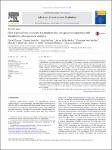First report of two complete Clostridium chauvoei genome sequences and detailed in silico genome analysis
Thomas, Prasad
Semmler, Torsten
Eichhorn, Inga
Lübke-Becker, Antina
Werckenthin, Christiane
Abdel-Glil, Mostafa Y.
Wieler, Lothar H.
Neubauer, Heinrich
Seyboldt, Christian
Clostridium (C.) chauvoei is a Gram-positive, spore forming, anaerobic bacterium. It causes black leg in ruminants, a typically fatal histotoxic myonecrosis. High quality circular genome sequences were generated for the C. chauvoei type strain DSM 7528T (ATCC 10092T) and a field strain 12S0467 isolated in Germany. The origin of replication (oriC) was comparable to that of Bacillus subtilis in structure with two regions containing DnaA boxes. Similar prophages were identified in the genomes of both C. chauvoei strains which also harbored hemolysin and bacterial spore formation genes. A CRISPR type I-B system with limited variations in the repeat number was identified. Sporulation and germination process related genes were homologous to that of the Clostridia cluster I group but novel variations for regulatory genes were identified indicative for strain specific control of regulatory events. Phylogenomics showed a higher relatedness to C. septicum than to other so far sequenced genomes of species belonging to the genus Clostridium. Comparative genome analysis of three C. chauvoei circular genome sequences revealed the presence of few inversions and translocations in locally collinear blocks (LCBs). The species genome also shows a large number of genes involved in proteolysis, genes for glycosyl hydrolases and metal iron transportation genes which are presumably involved in virulence and survival in the host. Three conserved flagellar genes (fliC) were identified in each of the circular genomes. In conclusion this is the first comparative analysis of circular genomes for the species C. chauvoei, enabling insights into genome composition and virulence factor variation.
No license information

